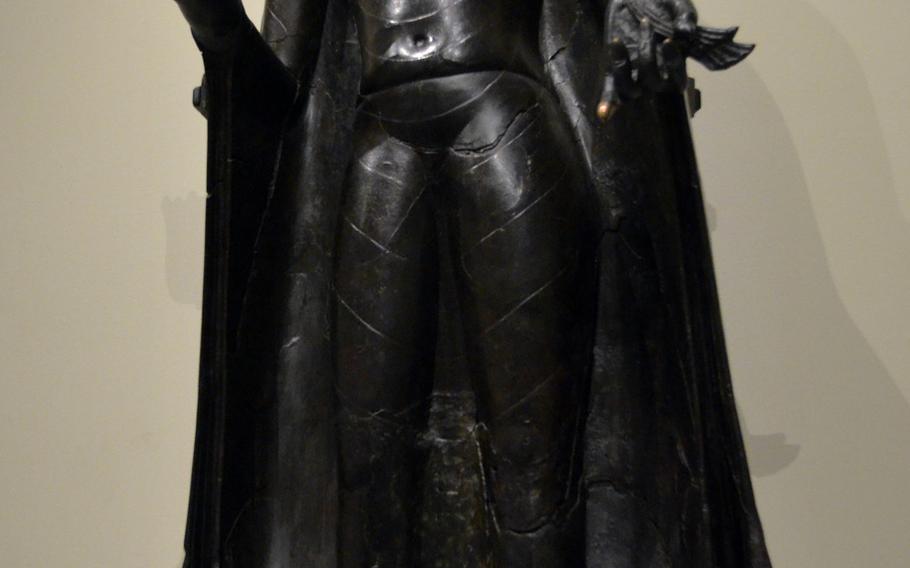
The seventh-century Sultanganj Buddha statue inside the Faith in Birmingham gallery at the Birmingham Museum and Art Gallery in Birmingham, England. The 6-foot-tall Buddhawas one of the first objects donated to the museum. (William Howard/Stars and Stripes)
I recently spent a peaceful afternoon at the Birmingham Museum and Art Gallery, marveling at its impressive collection of art and artifacts, many of international importance.
Besides fine art, ceramics and jewelry, the museum offers exhibits on natural history, archaeology, ethnography, local history and industrial history.
The collection includes currency from the Middle Ages and ancient relics from India, Central Asia, Cyprus and Egypt. The Egypt Gallery alone features artifacts from more 3,000 years of Egyptian life, culture and religious belief.
In a gallery dedicated to the Staffordshire Hoard — discovered in 2009 in a field by the village of Hammerwich, near Lichfield, in Staffordshire, England — I saw the largest hoard of Anglo-Saxon treasure yet found, consisting of more than 3,500 items, including 11 pounds of gold and 3,500 pieces of garnet cloisonne jewelry.
I was engrossed in studying the jewelry until I noticed a replica Viking broadsword and seax, or dagger, hanging on a far wall.
The jewelry was quickly forgotten. I would have liked to have tried out the weapon, but the museum wisely attached the blades to the wall. I managed to lift them only slightly.
Inside the museum’s new Faith in Birmingham gallery, the 6-foot-tall Sultanganj Buddha greets visitors with a serene stare. The seventh-century figure was discovered in the Indian state of Bihar in 1861.
The fine art portion of the museum has paintings and sculptures from the 14th to the 21st centuries, but my main interest was in the works by the Pre-Raphaelite Brotherhood, a group of English painters, poets and critics founded in 1848.
Birmingham Museums Trust, which runs nine museum sites in Birmingham, boasts the most important collection of Pre-Raphaelite art anywhere in the world, with more than 3,000 paintings, drawings, prints and examples of decorative art and design. It has the largest collection of works by Edward Burne-Jones in the world.
Burne-Jones’ work was a major influence on the development of other 19th-century modern art movements, such as art nouveau and the aesthetic movement.
Knowing the history behind some of the works brings them to life and makes them more interesting, as I found when looking at Rossetti’s painting, “Proserpine.” Jane Morris, the painting’s model, was the wife of William Morris, an English textile designer and writer associated with the Pre-Raphaelite Brotherhood.
Jane embodied the Pre-Raphaelite ideal of beauty and was a muse to both her husband and Rossetti, who was her lover. She inspired Rossetti to write poetry and create some of his best paintings.
Overall I explored about 40 rooms in my first trip to the Birmingham Museum.
I left with sore feet, a number of paintings checked off my must-see list and an edifying experience that I hope to never forget.
Birmingham Museum and Art Gallery DIRECTIONS
The Birmingham Museum and Art Gallery is located on Chamberlain Square, Birmingham B3 3DH, England. The museum is about a 2 ½-hour drive from RAF Mildenhall via the A14 and M6. The nearest available parking is at the Grand Central Light Rail Station. It’s a short walk to the museum, located in Victoria Square.
HOURS
10:30 a.m. to 5 p.m. Fridays; 10 a.m. to 5 p.m. Saturdays-Thursdays
COSTS
Admission is free.
FOOD
The museum’s newly renovated Edwardian Tearooms offer brunch and lunch main courses, high tea service, specialty cheese and wine platters, puddings and cakes.
INFORMATION
Phone: (+44) (121) 348-8032, email: bmag.enquiries@birminghammuseums.org.uk, website: www.birminghammuseums.org.uk